Fundamentals of Nutrition: Unit 4 Food Intake and Control Homework
VerifiedAdded on 2022/11/25
|6
|1622
|403
Homework Assignment
AI Summary
This assignment explores the topic of food intake and control, covering key concepts such as energy balance, and the consequences of imbalance. It also explains the concept of Maslow's hierarchy of needs, and homeostasis. The assignment further explores the student's dietary preferences and eating habits, and discusses the regulation of food intake, including the glucostatic and lipostatic theories. The student defines and differentiates between hunger, satiety, and appetite, and touches upon Pavlov's work, the hormone ghrelin, and the parasympathetic and sympathetic nervous systems' influence on the gastrointestinal tract. The assignment also investigates the brain's role in food intake, the hormone leptin, and the significance of food access and availability, and the function of appetite. References to relevant research papers and books are also included.
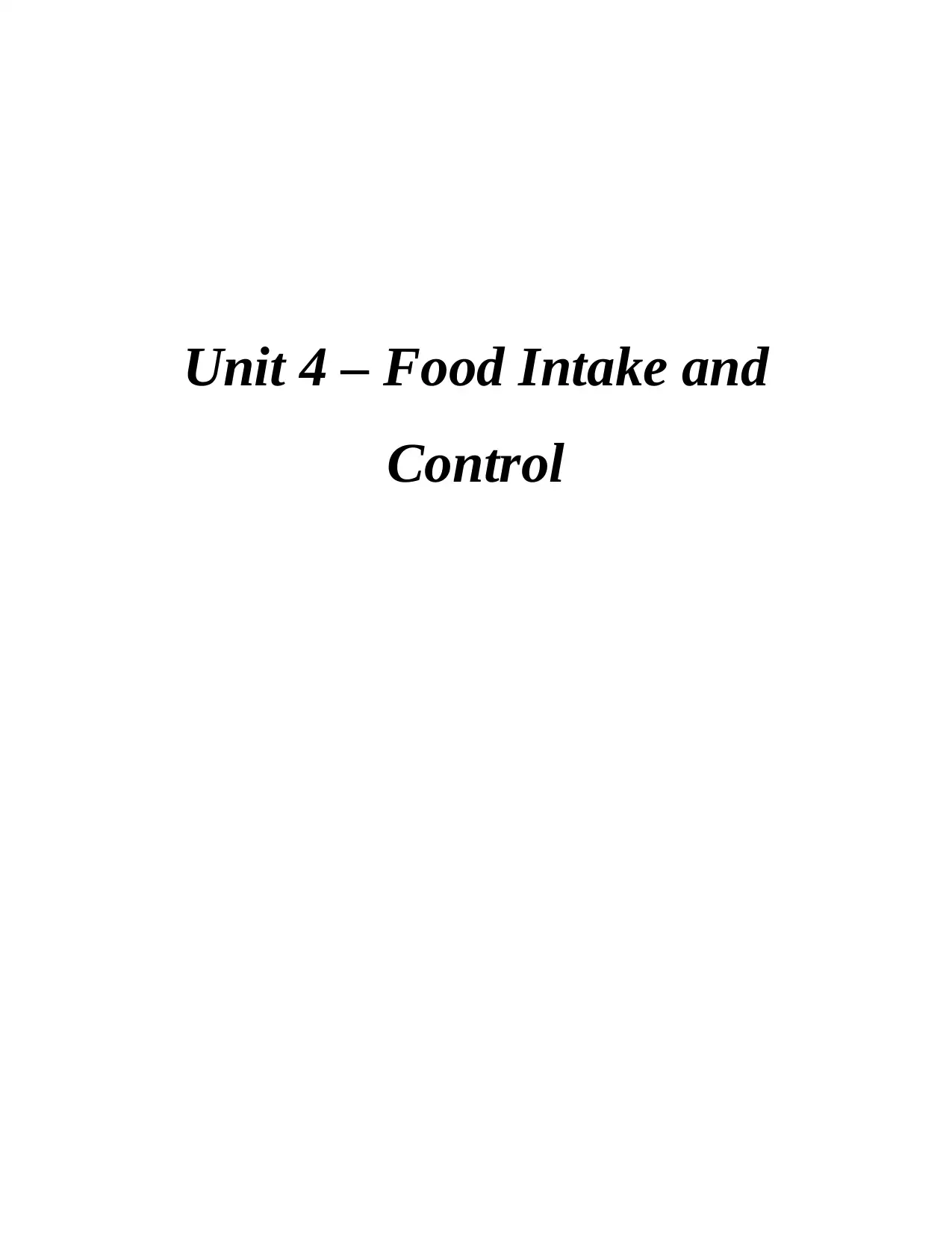
Unit 4 – Food Intake and
Control
Control
Paraphrase This Document
Need a fresh take? Get an instant paraphrase of this document with our AI Paraphraser
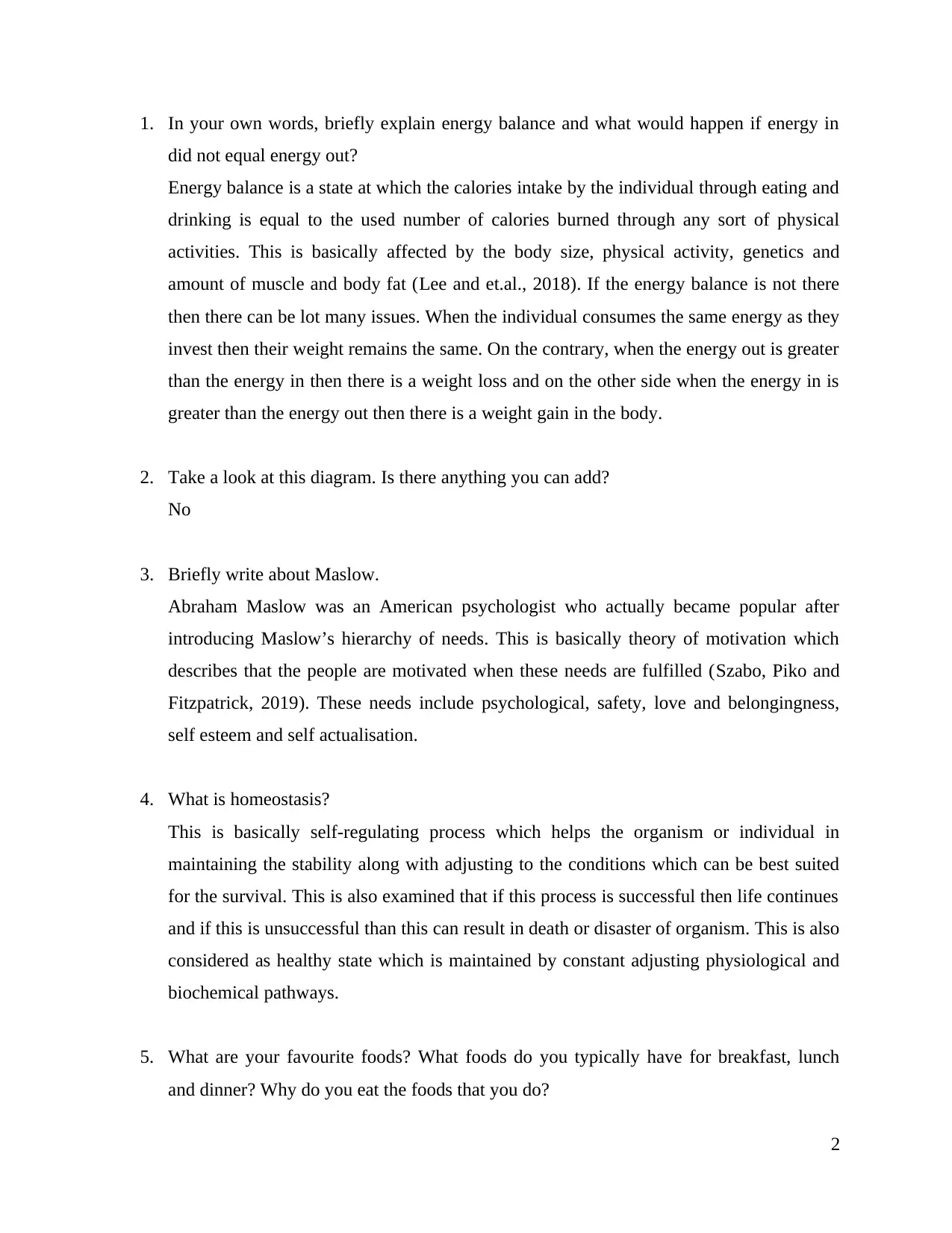
1. In your own words, briefly explain energy balance and what would happen if energy in
did not equal energy out?
Energy balance is a state at which the calories intake by the individual through eating and
drinking is equal to the used number of calories burned through any sort of physical
activities. This is basically affected by the body size, physical activity, genetics and
amount of muscle and body fat (Lee and et.al., 2018). If the energy balance is not there
then there can be lot many issues. When the individual consumes the same energy as they
invest then their weight remains the same. On the contrary, when the energy out is greater
than the energy in then there is a weight loss and on the other side when the energy in is
greater than the energy out then there is a weight gain in the body.
2. Take a look at this diagram. Is there anything you can add?
No
3. Briefly write about Maslow.
Abraham Maslow was an American psychologist who actually became popular after
introducing Maslow’s hierarchy of needs. This is basically theory of motivation which
describes that the people are motivated when these needs are fulfilled (Szabo, Piko and
Fitzpatrick, 2019). These needs include psychological, safety, love and belongingness,
self esteem and self actualisation.
4. What is homeostasis?
This is basically self-regulating process which helps the organism or individual in
maintaining the stability along with adjusting to the conditions which can be best suited
for the survival. This is also examined that if this process is successful then life continues
and if this is unsuccessful than this can result in death or disaster of organism. This is also
considered as healthy state which is maintained by constant adjusting physiological and
biochemical pathways.
5. What are your favourite foods? What foods do you typically have for breakfast, lunch
and dinner? Why do you eat the foods that you do?
2
did not equal energy out?
Energy balance is a state at which the calories intake by the individual through eating and
drinking is equal to the used number of calories burned through any sort of physical
activities. This is basically affected by the body size, physical activity, genetics and
amount of muscle and body fat (Lee and et.al., 2018). If the energy balance is not there
then there can be lot many issues. When the individual consumes the same energy as they
invest then their weight remains the same. On the contrary, when the energy out is greater
than the energy in then there is a weight loss and on the other side when the energy in is
greater than the energy out then there is a weight gain in the body.
2. Take a look at this diagram. Is there anything you can add?
No
3. Briefly write about Maslow.
Abraham Maslow was an American psychologist who actually became popular after
introducing Maslow’s hierarchy of needs. This is basically theory of motivation which
describes that the people are motivated when these needs are fulfilled (Szabo, Piko and
Fitzpatrick, 2019). These needs include psychological, safety, love and belongingness,
self esteem and self actualisation.
4. What is homeostasis?
This is basically self-regulating process which helps the organism or individual in
maintaining the stability along with adjusting to the conditions which can be best suited
for the survival. This is also examined that if this process is successful then life continues
and if this is unsuccessful than this can result in death or disaster of organism. This is also
considered as healthy state which is maintained by constant adjusting physiological and
biochemical pathways.
5. What are your favourite foods? What foods do you typically have for breakfast, lunch
and dinner? Why do you eat the foods that you do?
2
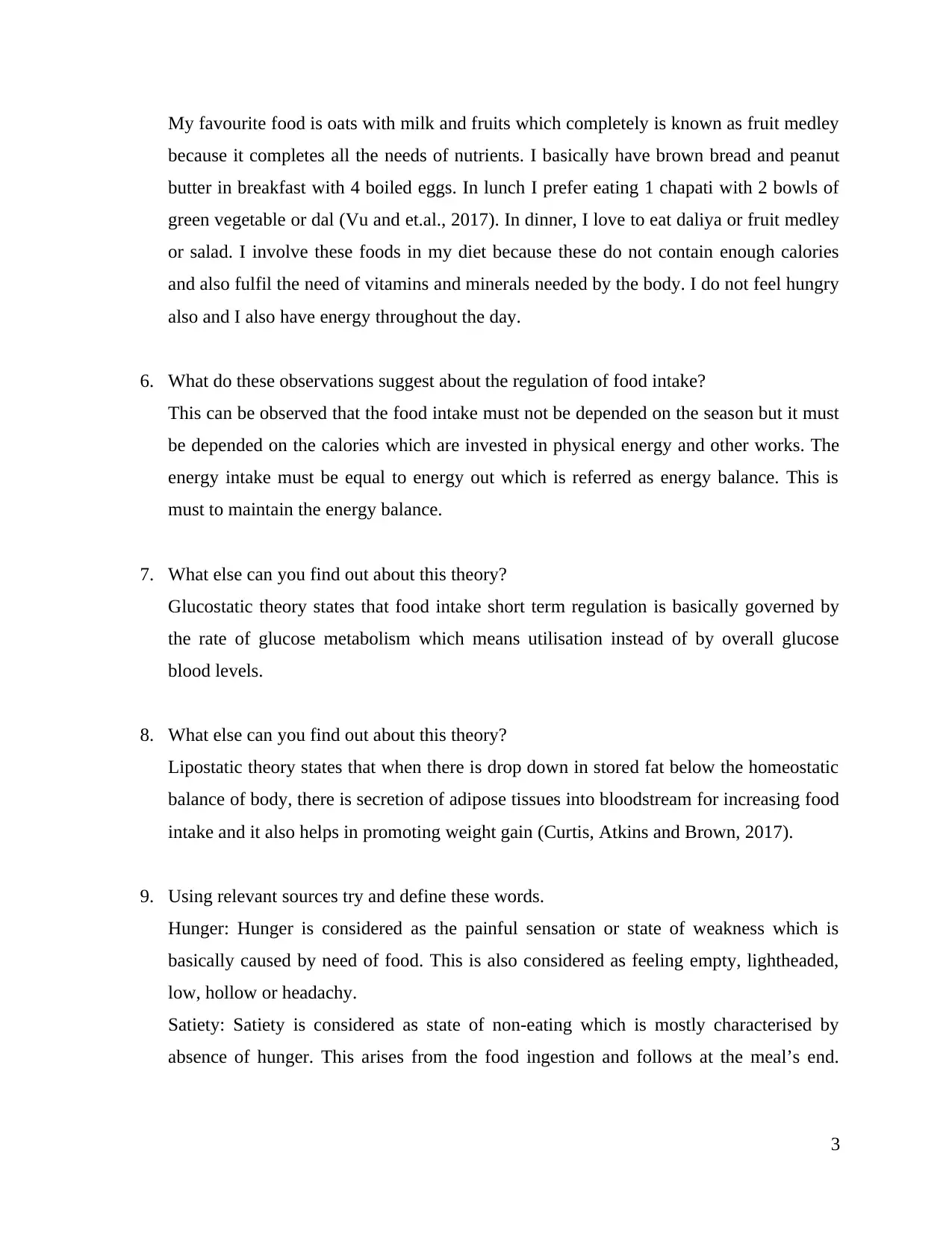
My favourite food is oats with milk and fruits which completely is known as fruit medley
because it completes all the needs of nutrients. I basically have brown bread and peanut
butter in breakfast with 4 boiled eggs. In lunch I prefer eating 1 chapati with 2 bowls of
green vegetable or dal (Vu and et.al., 2017). In dinner, I love to eat daliya or fruit medley
or salad. I involve these foods in my diet because these do not contain enough calories
and also fulfil the need of vitamins and minerals needed by the body. I do not feel hungry
also and I also have energy throughout the day.
6. What do these observations suggest about the regulation of food intake?
This can be observed that the food intake must not be depended on the season but it must
be depended on the calories which are invested in physical energy and other works. The
energy intake must be equal to energy out which is referred as energy balance. This is
must to maintain the energy balance.
7. What else can you find out about this theory?
Glucostatic theory states that food intake short term regulation is basically governed by
the rate of glucose metabolism which means utilisation instead of by overall glucose
blood levels.
8. What else can you find out about this theory?
Lipostatic theory states that when there is drop down in stored fat below the homeostatic
balance of body, there is secretion of adipose tissues into bloodstream for increasing food
intake and it also helps in promoting weight gain (Curtis, Atkins and Brown, 2017).
9. Using relevant sources try and define these words.
Hunger: Hunger is considered as the painful sensation or state of weakness which is
basically caused by need of food. This is also considered as feeling empty, lightheaded,
low, hollow or headachy.
Satiety: Satiety is considered as state of non-eating which is mostly characterised by
absence of hunger. This arises from the food ingestion and follows at the meal’s end.
3
because it completes all the needs of nutrients. I basically have brown bread and peanut
butter in breakfast with 4 boiled eggs. In lunch I prefer eating 1 chapati with 2 bowls of
green vegetable or dal (Vu and et.al., 2017). In dinner, I love to eat daliya or fruit medley
or salad. I involve these foods in my diet because these do not contain enough calories
and also fulfil the need of vitamins and minerals needed by the body. I do not feel hungry
also and I also have energy throughout the day.
6. What do these observations suggest about the regulation of food intake?
This can be observed that the food intake must not be depended on the season but it must
be depended on the calories which are invested in physical energy and other works. The
energy intake must be equal to energy out which is referred as energy balance. This is
must to maintain the energy balance.
7. What else can you find out about this theory?
Glucostatic theory states that food intake short term regulation is basically governed by
the rate of glucose metabolism which means utilisation instead of by overall glucose
blood levels.
8. What else can you find out about this theory?
Lipostatic theory states that when there is drop down in stored fat below the homeostatic
balance of body, there is secretion of adipose tissues into bloodstream for increasing food
intake and it also helps in promoting weight gain (Curtis, Atkins and Brown, 2017).
9. Using relevant sources try and define these words.
Hunger: Hunger is considered as the painful sensation or state of weakness which is
basically caused by need of food. This is also considered as feeling empty, lightheaded,
low, hollow or headachy.
Satiety: Satiety is considered as state of non-eating which is mostly characterised by
absence of hunger. This arises from the food ingestion and follows at the meal’s end.
3
⊘ This is a preview!⊘
Do you want full access?
Subscribe today to unlock all pages.

Trusted by 1+ million students worldwide
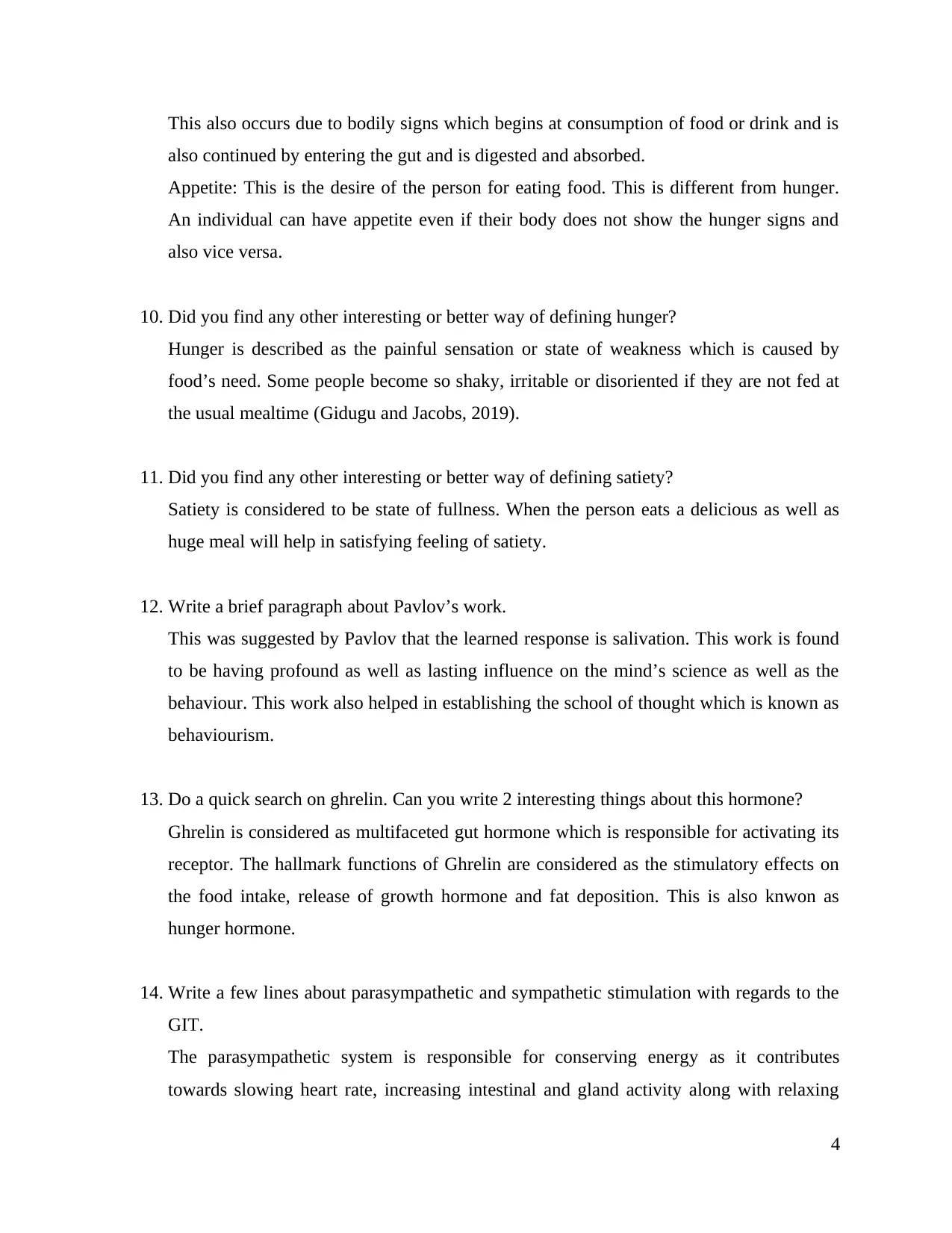
This also occurs due to bodily signs which begins at consumption of food or drink and is
also continued by entering the gut and is digested and absorbed.
Appetite: This is the desire of the person for eating food. This is different from hunger.
An individual can have appetite even if their body does not show the hunger signs and
also vice versa.
10. Did you find any other interesting or better way of defining hunger?
Hunger is described as the painful sensation or state of weakness which is caused by
food’s need. Some people become so shaky, irritable or disoriented if they are not fed at
the usual mealtime (Gidugu and Jacobs, 2019).
11. Did you find any other interesting or better way of defining satiety?
Satiety is considered to be state of fullness. When the person eats a delicious as well as
huge meal will help in satisfying feeling of satiety.
12. Write a brief paragraph about Pavlov’s work.
This was suggested by Pavlov that the learned response is salivation. This work is found
to be having profound as well as lasting influence on the mind’s science as well as the
behaviour. This work also helped in establishing the school of thought which is known as
behaviourism.
13. Do a quick search on ghrelin. Can you write 2 interesting things about this hormone?
Ghrelin is considered as multifaceted gut hormone which is responsible for activating its
receptor. The hallmark functions of Ghrelin are considered as the stimulatory effects on
the food intake, release of growth hormone and fat deposition. This is also knwon as
hunger hormone.
14. Write a few lines about parasympathetic and sympathetic stimulation with regards to the
GIT.
The parasympathetic system is responsible for conserving energy as it contributes
towards slowing heart rate, increasing intestinal and gland activity along with relaxing
4
also continued by entering the gut and is digested and absorbed.
Appetite: This is the desire of the person for eating food. This is different from hunger.
An individual can have appetite even if their body does not show the hunger signs and
also vice versa.
10. Did you find any other interesting or better way of defining hunger?
Hunger is described as the painful sensation or state of weakness which is caused by
food’s need. Some people become so shaky, irritable or disoriented if they are not fed at
the usual mealtime (Gidugu and Jacobs, 2019).
11. Did you find any other interesting or better way of defining satiety?
Satiety is considered to be state of fullness. When the person eats a delicious as well as
huge meal will help in satisfying feeling of satiety.
12. Write a brief paragraph about Pavlov’s work.
This was suggested by Pavlov that the learned response is salivation. This work is found
to be having profound as well as lasting influence on the mind’s science as well as the
behaviour. This work also helped in establishing the school of thought which is known as
behaviourism.
13. Do a quick search on ghrelin. Can you write 2 interesting things about this hormone?
Ghrelin is considered as multifaceted gut hormone which is responsible for activating its
receptor. The hallmark functions of Ghrelin are considered as the stimulatory effects on
the food intake, release of growth hormone and fat deposition. This is also knwon as
hunger hormone.
14. Write a few lines about parasympathetic and sympathetic stimulation with regards to the
GIT.
The parasympathetic system is responsible for conserving energy as it contributes
towards slowing heart rate, increasing intestinal and gland activity along with relaxing
4
Paraphrase This Document
Need a fresh take? Get an instant paraphrase of this document with our AI Paraphraser
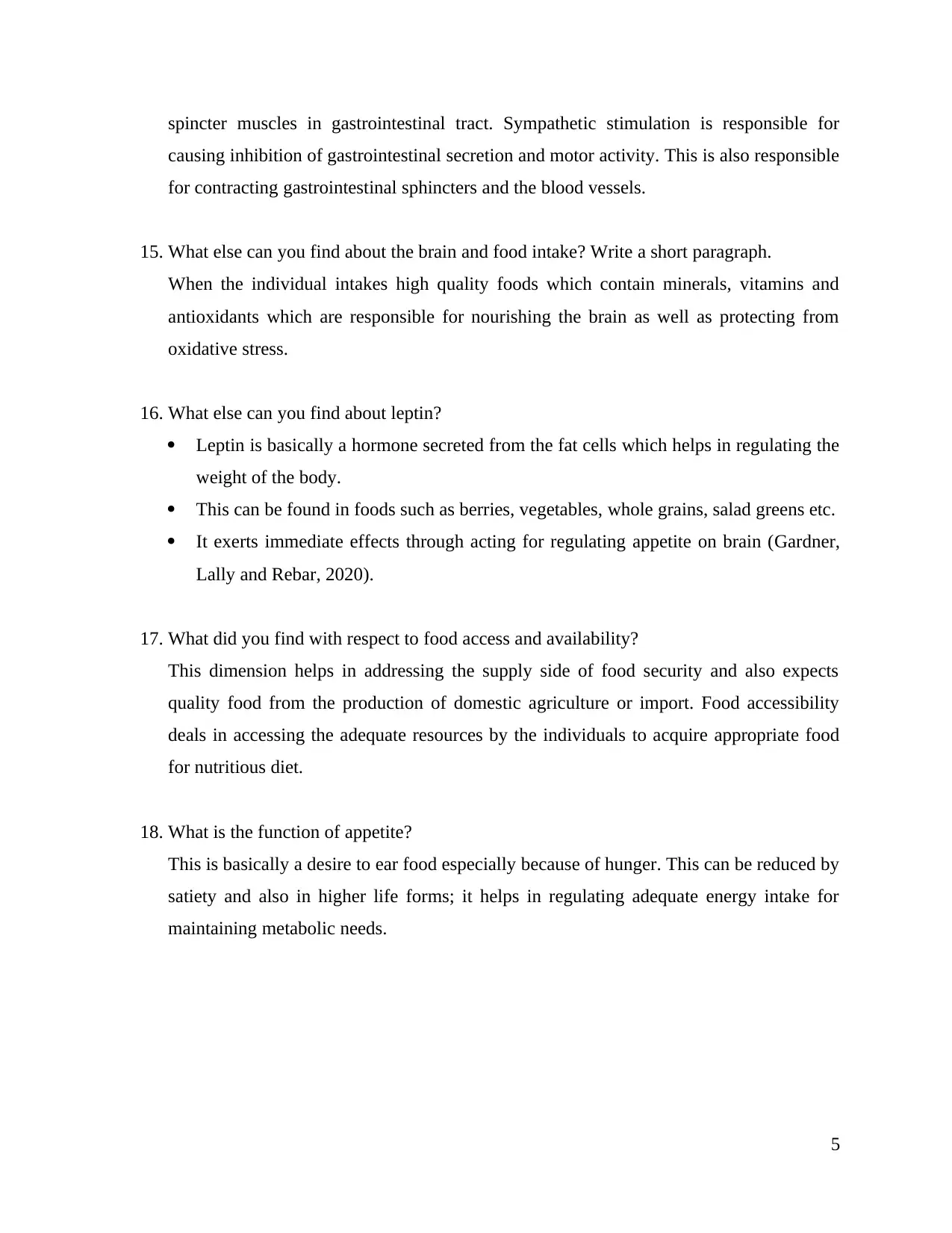
spincter muscles in gastrointestinal tract. Sympathetic stimulation is responsible for
causing inhibition of gastrointestinal secretion and motor activity. This is also responsible
for contracting gastrointestinal sphincters and the blood vessels.
15. What else can you find about the brain and food intake? Write a short paragraph.
When the individual intakes high quality foods which contain minerals, vitamins and
antioxidants which are responsible for nourishing the brain as well as protecting from
oxidative stress.
16. What else can you find about leptin?
Leptin is basically a hormone secreted from the fat cells which helps in regulating the
weight of the body.
This can be found in foods such as berries, vegetables, whole grains, salad greens etc.
It exerts immediate effects through acting for regulating appetite on brain (Gardner,
Lally and Rebar, 2020).
17. What did you find with respect to food access and availability?
This dimension helps in addressing the supply side of food security and also expects
quality food from the production of domestic agriculture or import. Food accessibility
deals in accessing the adequate resources by the individuals to acquire appropriate food
for nutritious diet.
18. What is the function of appetite?
This is basically a desire to ear food especially because of hunger. This can be reduced by
satiety and also in higher life forms; it helps in regulating adequate energy intake for
maintaining metabolic needs.
5
causing inhibition of gastrointestinal secretion and motor activity. This is also responsible
for contracting gastrointestinal sphincters and the blood vessels.
15. What else can you find about the brain and food intake? Write a short paragraph.
When the individual intakes high quality foods which contain minerals, vitamins and
antioxidants which are responsible for nourishing the brain as well as protecting from
oxidative stress.
16. What else can you find about leptin?
Leptin is basically a hormone secreted from the fat cells which helps in regulating the
weight of the body.
This can be found in foods such as berries, vegetables, whole grains, salad greens etc.
It exerts immediate effects through acting for regulating appetite on brain (Gardner,
Lally and Rebar, 2020).
17. What did you find with respect to food access and availability?
This dimension helps in addressing the supply side of food security and also expects
quality food from the production of domestic agriculture or import. Food accessibility
deals in accessing the adequate resources by the individuals to acquire appropriate food
for nutritious diet.
18. What is the function of appetite?
This is basically a desire to ear food especially because of hunger. This can be reduced by
satiety and also in higher life forms; it helps in regulating adequate energy intake for
maintaining metabolic needs.
5

REFERENCES
Books and Journals
Bacon, L. and Krpan, D., 2018. (Not) Eating for the environment: The impact of restaurant menu
design on vegetarian food choice. Appetite. 125. pp.190-200.
Curtis, K., Atkins, L. and Brown, K., 2017. Big hearts, small hands: a focus group study
exploring parental food portion behaviours. BMC Public Health. 17(1). pp.1-14.
Gardner, B., Lally, P. and Rebar, A.L., 2020. Does habit weaken the relationship between
intention and behaviour? Revisiting the habit‐intention interaction hypothesis. Social
and Personality Psychology Compass. 14(8). p.e12553.
Gidugu, V. and Jacobs, M.L., 2019. Empowering individuals with mental illness to develop
healthy eating habits through mindful eating: Results of a program
evaluation. Psychology, health & medicine. 24(2). pp.177-186.
Lee, H.C. and et.al., 2018. Will an organic label always increase food consumption? It depends
on food type and consumer differences in health locus of control. Food Quality and
Preference. 63. pp.88-96.
Szabo, K., Piko, B.F. and Fitzpatrick, K.M., 2019. Adolescents’ attitudes towards healthy eating:
The role of self-control, motives and self-risk perception. Appetite. 143. p.104416.
Vu, T. and et.al., 2017. Wearable food intake monitoring technologies: A comprehensive
review. Computers. 6(1). p.4.
6
Books and Journals
Bacon, L. and Krpan, D., 2018. (Not) Eating for the environment: The impact of restaurant menu
design on vegetarian food choice. Appetite. 125. pp.190-200.
Curtis, K., Atkins, L. and Brown, K., 2017. Big hearts, small hands: a focus group study
exploring parental food portion behaviours. BMC Public Health. 17(1). pp.1-14.
Gardner, B., Lally, P. and Rebar, A.L., 2020. Does habit weaken the relationship between
intention and behaviour? Revisiting the habit‐intention interaction hypothesis. Social
and Personality Psychology Compass. 14(8). p.e12553.
Gidugu, V. and Jacobs, M.L., 2019. Empowering individuals with mental illness to develop
healthy eating habits through mindful eating: Results of a program
evaluation. Psychology, health & medicine. 24(2). pp.177-186.
Lee, H.C. and et.al., 2018. Will an organic label always increase food consumption? It depends
on food type and consumer differences in health locus of control. Food Quality and
Preference. 63. pp.88-96.
Szabo, K., Piko, B.F. and Fitzpatrick, K.M., 2019. Adolescents’ attitudes towards healthy eating:
The role of self-control, motives and self-risk perception. Appetite. 143. p.104416.
Vu, T. and et.al., 2017. Wearable food intake monitoring technologies: A comprehensive
review. Computers. 6(1). p.4.
6
⊘ This is a preview!⊘
Do you want full access?
Subscribe today to unlock all pages.

Trusted by 1+ million students worldwide
1 out of 6
Related Documents
Your All-in-One AI-Powered Toolkit for Academic Success.
+13062052269
info@desklib.com
Available 24*7 on WhatsApp / Email
![[object Object]](/_next/static/media/star-bottom.7253800d.svg)
Unlock your academic potential
Copyright © 2020–2025 A2Z Services. All Rights Reserved. Developed and managed by ZUCOL.





